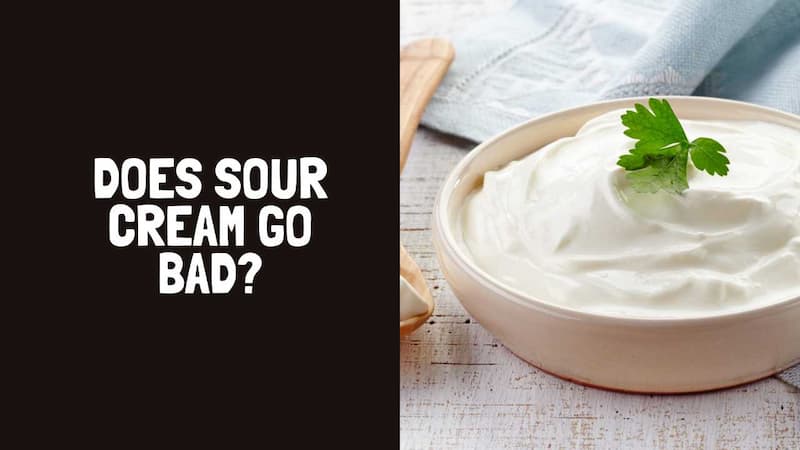You have an open container of sour cream in the fridge and it’s been there for at least a few days. At this point, you start thinking about how long the sour cream will last and what the signs are of spoilage. Check your sour cream to make sure it’s not moldy, discolored, or smelly. If nothing goes wrong, consider using it safely. In this article, I’ll cover how long sour cream last.
Table of Contents
What Causes Spoiling?
Sour cream is made from milk that has been pasteurized to kill the most harmful bacteria. It is then fermented by healthy bacteria, producing lactic acid, which gives it its sour taste. Commercially produced sour cream must meet safety standards, and homemade sour cream may introduce other types of bacteria. Think of sour cream as a living product, as it still contains active ingredients that were not killed by the aseptic canning process.
Can Sour Cream Go Bad?
All dairy products go bad, and so does sour cream. But, of course, some of them last longer and stay better. Sour cream is one of those products that doesn’t spoil within a few days of opening the container.
Obviously, it’s nowhere near buttery in terms of longevity, but it’s not that bad either. It’s longer than heavy cream anyway.
How Long Does Sour Cream Last?

A fresh container of sour cream has a shelf life of one week (up to two weeks) past the date on the label. Leftover sour cream should retain quality for a few days to two weeks after opening.
Each container has a date on the label. In most cases, this is a “before use” or “best before” date. So an often asked question is how long the sour cream lasts after the day. In short, it’s hard to say.
The product is already sour, so it’s likely to retain quality for a week, and sometimes even two weeks after that date.
But it’s a dairy product, so if it’s not handled properly in storage before putting it in the refrigerator, it can go bad earlier, even before the date on the label.
How To Tell If Sour Cream Is Bad?
There are four signs of spoiled sour cream: mold, altered texture, off-flavor, and bad taste.
Color – The sour cream should remain white. Bacterial growth can manifest as a color change including yellow, blue, or pink, but if you see any color change, throw it away.
Mold – Check the inside of the lid and the surface of the sour cream for mold. Don’t think you can scrape off any mold on top and use the rest, it may have spread all over the tub without being visible.
Texture – just keep the solids and liquids separate, you can mix the sour cream together and it’s still delicious. If you notice any lumps, your sour cream has gone bad and should be thrown away.
Smell – Although the sour cream is a bit sour at first, it will be very clear as it goes bad or spoils. The taste will be unpleasant and sour, indicating that the sour cream is not safe.
Taste – if you’re still unsure, taste a small amount. Dispose of it if it has a sharp bitter taste.
What Happens If You Eat Bad Sour Cream?
As we mentioned, sour cream is a very good environment for many different bacteria and molds. These stinks can even grow in the refrigerator.
Consuming poor-quality sour cream puts you at risk for food poisoning, which can be mild or severe, depending on a variety of factors.
If you are unfortunate enough to have food poisoning, you may experience stomach pain, nausea, diarrhea, and fever. It may appear within hours or days of consuming bad sour cream.
How To Store Sour Cream
You store sour cream the same way you store other dairy products like yogurt or buttermilk.
First, keep it refrigerated all the time, if you can, in a far corner, not the door where the temperature fluctuates the most.
If you put sour cream in that far corner, make a plan for how and when it will be used so it doesn’t get forgotten and tossed out in a few weeks.
Once you open the container, always seal it.
If it only has a foil seal, consider transferring it to an airtight container, especially if you expect to store it in the refrigerator for more than a few days.
As with other condiments, always scoop the sour cream with a clean spoon. I know it’s easier to use a spoon you already have than a new one when you’re preparing a salad, but it’s important not to be lazy here.
“Double soaking” is never a good idea, especially with condiments that go bad like sour cream.
If you accidentally leave sour cream out overnight, just throw it away, whether the container is unopened or not. The product might be ok, but you never know, and in this case, it’s best to proceed with caution.
Can You Freeze Sour Cream?
Most manufacturers recommend not freezing sour cream. Like buttermilk and many other dairy products, sour cream separates when thawed.
While you can restore some of the consistency by lightly whipping it, it won’t turn out as well as fresh sour cream.
How to Freeze Sour Cream
Since you only need a small amount of product at a time, it’s best to freeze it in an ice cube tray or muffin tin.
To do this, just pour the sour cream into a container of your choice and toss it in the freezer.
Once the cubes are frozen, transfer them to a freezer bag and return to the freezer.
Whenever you need sour cream, take as many cubes as you need from the bag and use it.
If you need sour cream for soup, you can just toss the frozen cubes into the pot.
When defrosting, it is best to keep it in the refrigerator overnight.
Summary
An unopened container will keep for a week or even two weeks after the date on the label.
Once opened, it can retain quality, even for up to two weeks.

